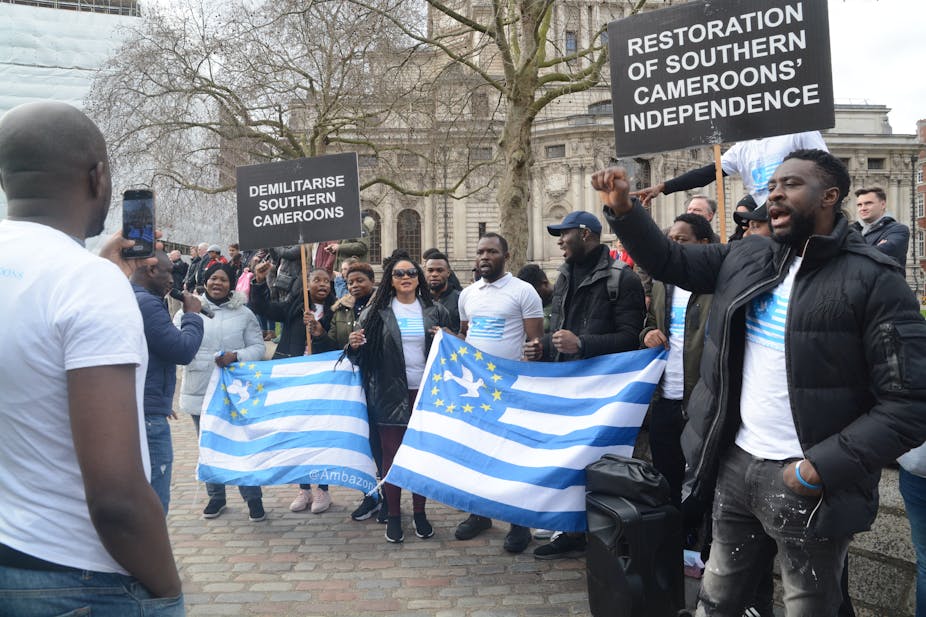Cameroon’s separatist insurgency is an armed conflict in the country’s North West (NW) and South West (SW) regions that began in 2017. It pits government forces against several non-state armed groups, locally known as “Amba rebels”.
The rebels seek to create a state called Ambazonia out of Cameroon’s English-speaking regions. The conflict has killed over 6,000 people and displaced 765,000. Over 70,000 are refugees in Nigeria. More than 2 million need humanitarian support and 600,000 children have been deprived of effective schooling.
As an international security scholar with an interest in small wars, I have been studying Cameroon’s security for a decade. I recently published research on the factors that have contributed to the separatist insurgency.
The factors include a protest by teachers and lawyers, colonial heritage, a history of insurgencies, and an internal geography conducive to group conflict and guerrilla warfare. Others are poor macroeconomic performance, ability to finance authoritarianism without relying on taxes, a turbulent regional neighbourhood and unfavourable international relations.
I argue further that the conflict has stalled because the rebels lack the numbers, money and cohesion to move beyond an insurgency. This makes a rebel victory impossible. But multiple insurgencies can undermine the state and, therefore, continue to be national security threats. And Cameroon’s strategic location between west and central Africa means insecurity in the country could destabilise the region.
Factors that led to the insurgency
A major factor that led to the insurgency was the teachers’ and lawyers’ protests in 2016, arising from longstanding grievances of Cameroon’s English-speaking minority. The English-speakers complained of the use of French in schools and courts in the NW and SW regions, marginalisation in high-level government appointments, neglect in public investment in infrastructure in their regions, and generally poor economic conditions.
Another factor is the miscalculated application of force by the government and the rebels. The government, accustomed to the use of violence in repressing dissent, assumed it could silence the protests forcefully. The arrest of the protest leaders and brutal crackdown on protesters spurred on the insurgents. But the rebels also misread the situation. They saw the age of the president, Paul Biya (91), his longevity in office and pending elections in 2018 as indicating weakness. They assumed that a demonstration of concerted force would bring about the fall of the government.
Read more: Cameroon's Anglophone crisis: how the common law court offers a ray of hope
Cameroon has suffered from poor macroeconomic performance and authoritarianism with slow political development. I also discovered through my research that the increasing decay of traditional authority has reduced government capacity to provide social order in semi-urban and rural areas.
Regional disorder in central and west Africa has contributed to the insurgency too. The disorder includes the Boko Haram insurgency in the Lake Chad Basin, insurgencies in eastern Chad, separatist violence in the eastern part of Nigeria and resources-related violence in the Niger Delta of Nigeria. The Central African Republic has been in a civil war since 2013. The different armed conflicts in the region create flows of military supplies and skills.
Cameroon’s position in the US-led political economy is another factor. Exporting raw materials and importing manufactured goods makes it vulnerable to fluctuations in world market prices and less able to provide for its citizens.
Moving forward
In my view, the rebels cannot turn the conflict into a larger war. This means the insurgency will remain stalled until the government is willing or able to decide the issue.
The rebels cannot achieve their objective of changing the form of the Cameroonian state or gaining independence.
My argument rests on the following reasons.
A larger form of war, which would make a rebel victory possible, requires a cause that unites a population large enough to form a military with tens of thousands of combatants. Ethnic divisions between the armed and political groups demonstrate that the independence cause is not strong enough to displace other interests.
Cameroon has over 20 ethnic groups in a population of 29 million. The “anglophone” identity has not displaced ethnic affiliation. Most armed groups are small and organised on ethnic lines. They are restricted to hit-and-run attacks and can’t hold territory.
Rebel victory requires consistent funding. The insurgency has, thus far, sourced funding mainly from remittances from Cameroon’s diaspora separatists and criminal activity in the region. The funding is intermittent. Corruption among the diaspora groups means that money raised rarely reaches the fighting groups. Criminal activity, like the distribution of contraband and drug networks, is periodically disrupted.
The rebels have not succeeded in establishing reliable logistics. The sustained intensity necessary to win a war is impossible without reliable supplies.
The three principal shortcomings mean the war cannot become anything more than a peripheral insurgency. The Cameroonian government can live with a peripheral insurgency.
Implications of the insurgency
Instability in Cameroon will have a negative impact on francophone central Africa. Cameroon is the region’s second-largest country in population and economy. It accounted for about 40% of the GDP of central African countries using the CFA franc in 2022. Chad, the Central African Republic, Congo, Equatorial Guinea and Gabon rely on Cameroon for agricultural products and infrastructure (ports, telecoms and roads).
Read more: Cameroon's anglophone conflict has lasted for six years: what citizens say about how to end it
The insurgency also affects Nigeria, Africa’s economic and population giant, and thus the region. Nigeria’s GDP accounts for well over 50% of the economies of Ecowas member states.
The conflict’s potential destabilising effects is also of interest to foreign investors and policymakers further afield.

